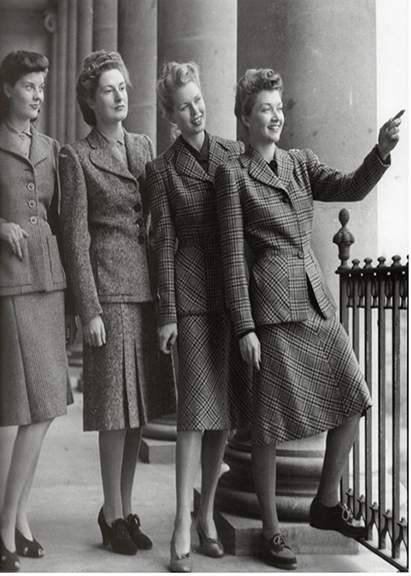
In the early 1940s women’s fashion was greatly impacted due to World War II as France had been overtaken by the Germans in 1940. Due to the German occupation, France had no influence on the worlds fashion industry. As a result, women’s fashion took a simple approach minimizing pleats and frills to conserve resources. After the attack on Pearl Harbor on December 7, 1941, the U.S. Congress approved the Women’s Army Auxiliary Corps also known as WAAC. In 1942 they took numerous non-combat jobs within the military. Because of this most women would wear military clothes. If women were not wearing their military uniform, then they would be wearing simple dresses. The clothes worn appeared more masculine as they were modest, had padded shoulders, and would have a boxy look. After the war, fashion became more feminine again with the New Look silhouette.
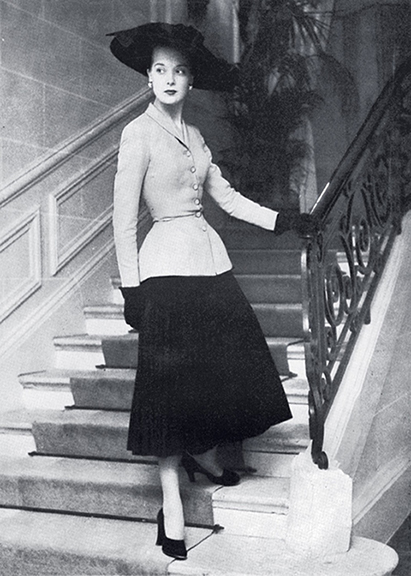
Dior’s inspiration for the design was remembering the femininity and silhouette that his mother wore. He brought the hourglass figure with the New Look. One of the most well-known looks where the Bar Suit as seen in the image. The New Look was not well received with everyone, some women still preferred the utility fashion movement as they used less fabric and did not like how feminized the fashion was. However, despite those concerns the New Look was still very popular.
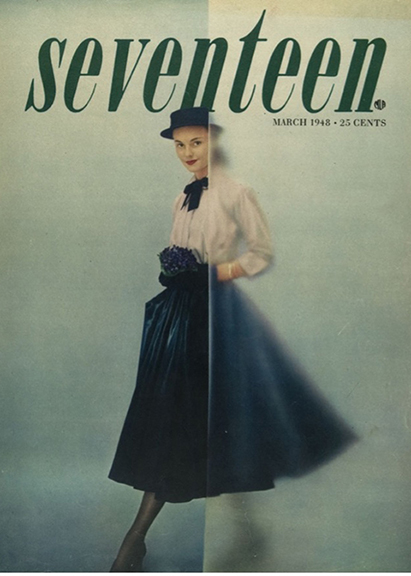
The Seventeen March 1948 edition designed by Cipe Pineles has a cold color palette with a hint of warm green at the top to show the warmer season coming. In this edition the model is fashioning the hourglass silhouette. This outfit may not have been designed by Dior, but it was influenced from his designs. The model on the Seventeen magazine has a sinched waist and it is enhanced with her large upper body and rounded shoulders. Also, by having her step forward she shows off her long-pleated skirt and because of its volume it gives the allusion of an hourglass figure.
I was drawn to this cover of Seventeen as it looks enchanting. Half of the cover appeared to be covered by a frosted window that gives the allusion that she is painted or out of focus. The way she is stepping forward looks graceful. Her long-pleated skirt catches my eye as it is paired with a white button up top with a bow that matches the color of her skirt. Her hat is lovely, hats are not worn commonly today other than baseball caps. I am drawn to the New Look as it is uncommon in modern day society. Fashion is not feminine anymore as most people wear loungewear such as baggy sweatshirts or even pajama pants out in public.
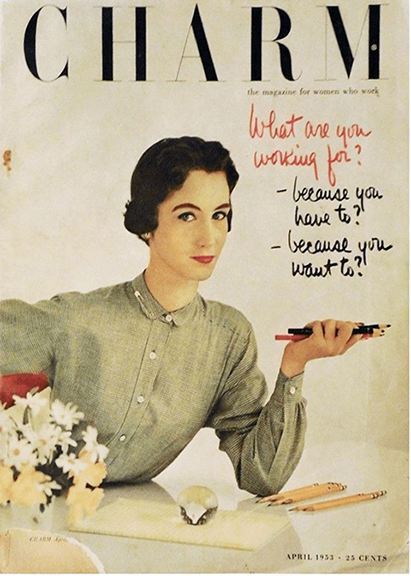
The cover of Charm April 1953 edition by Cipe Pineles resembled the Corolle line as she has the button up shirt with rounded shoulders which looks more feminine than the boxy clothes previously. However, she is more than likely leaning towards the Bar Suit style versus the New Look. This cover features a woman and has a few questions listed to the right of her which is directed towards women that asks, “What are you working for? Because you have to? Because you want to?”. Some women did not have the option to stay home as they needed to work because of low income, but other women who may have worked during World War II wanted to work because they enjoyed it even if they do not need to work. Today I feel that most women must work regardless of if they want to or not. The Bar Suit was an elegant, fashionable, and practical. The Bar Suit was perfect for women who wanted to work and look professional. This style also had a sinched waist, usually pared with a petticoat underneath to help enhance the hourglass figure. The model on the cover of Charm April 1953 has subtle make up, it is not bold and over the top like today where makeup is visibly caked on. The model has darkened eyebrows, eye liner, and an orange red lip stick. She has short hair but the way it is styled is lovely as she has gentle curls. Even the way she poses just exudes elegance.
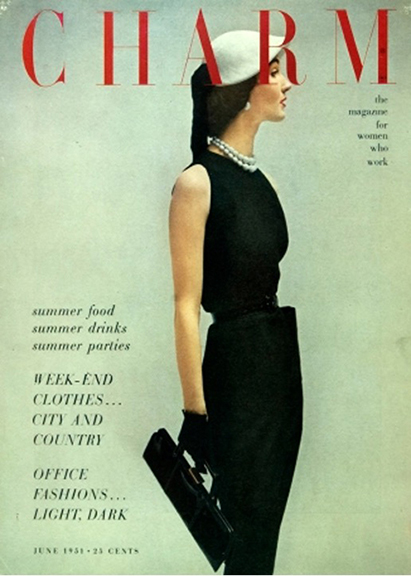
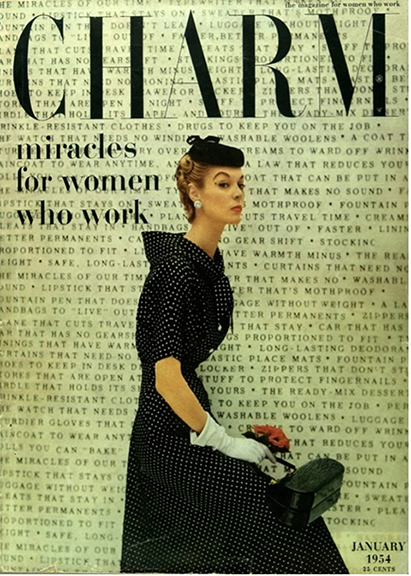
The model on Charm January 1954 edition looks sophisticated. Her pose gives off this feeling of superiority especially the way her head is tilted up and to the side. Her raised eyebrow as she is just glancing at the audience makes me feel like she is refined and has little time to waste. The title of this edition is “Miracles for women who work” which shows that this is something she would wear to work. Her dress is something I wish people would still wear today. It’s hard to find dresses like this in stores, when I go to the mall most clothes are ripped jeans or baggy clothes. To find something this beautiful one has to shop online, go to a specialty store, or make it themselves. Her white gloves stand out against her dark dress and help tie in her silver accessories and the white polka dots. People today use gloves mostly for the cold and not for fashion which is something that I miss along with her decorative hat. Pettie coats are also uncommon in modern times but should make a comeback as they add volume to a dress. With added layers it is easier to put pockets in a dress as it would be less obvious because of the volume or pleated skirts.
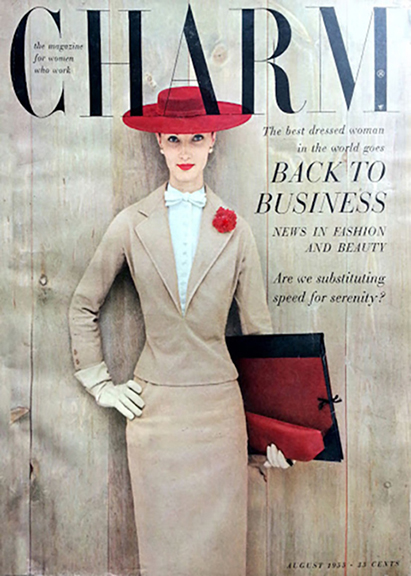
Resources:
Fashion History – https://fashionhistory.fitnyc.edu/1940-1949/
Vogue Magazine Archives – https://www.vogue.com/article/christian-dior-archival-looks
NYC Fashion History Timeline – https://www.vogue.com/article/christian-dior-archival-looks
Vintage Dancer – https://vintagedancer.com/1940s/what-did-women-wear-in-the-1940s/
Vintage Dancer – https://vintagedancer.com/1940s/1940s-dresses/
Vintage Dancer – https://vintagedancer.com/1950s/1950s-fashion-women-get-look/
Writing by Lillian Gutierrez
Lillian Gutierrez is a Sophomore Graphic Design and Marketing Major at USF. In addition to her studies she holds interest in video gaming, currently she is plans to play Final Fantasy VII Rebirth once her semester has wrapped up!


